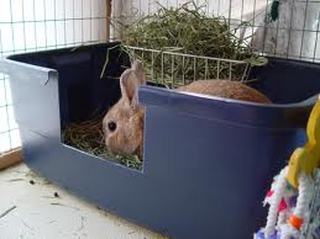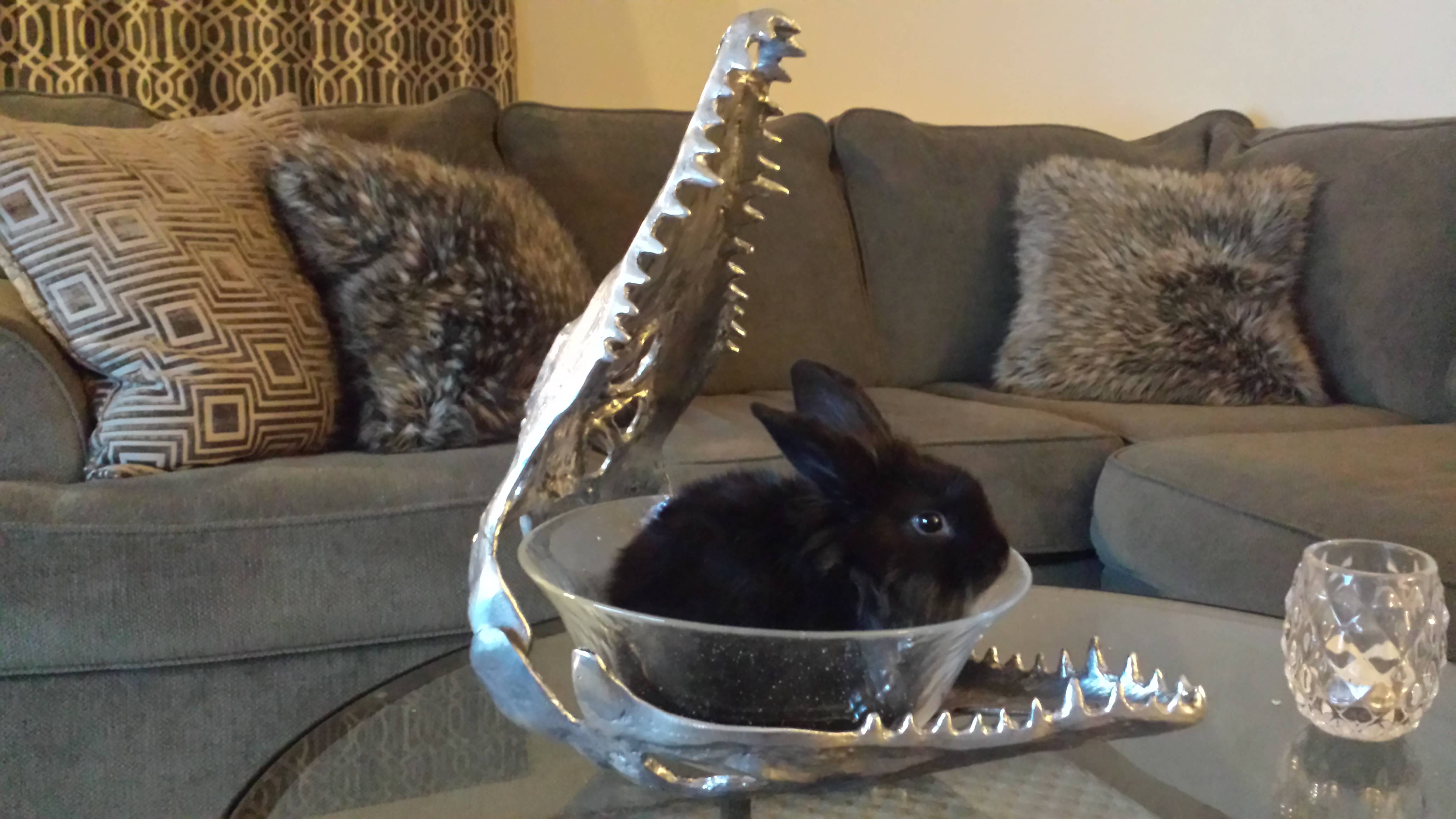I have heard that rabbits make good pets. How hard is it house break rabbits?
4 Answers
Rabbits are very clean and easy to train for litter tray use. In nature, rabbits spend a lot of time in hutches and warrens, so learning to use a corner rather than where ever they are keeps their living area clean. This means your job as a rabbit owner is much easier as evolution has done most of the hard work. Most...
Finding their "spot"
When first house training your rabbit, confine them to a small section of the house, preferable one that is easy to clean such as an area with non-absorbant flooring, like tiles or linoleum - as with all animals, rabbits will make mistakes at first. In this confined area, in the corners you want to play several small litter trays over newspaper to catch any spills. As suggested, if you can, place something that has been soiled into the trays to reinforce the smell - however be careful with which wood you use, why is discussed below in the section on litter.
Over time you will notice that your bunny will prefer one spot over another. As they start this preference, slowly remove the other trays one at a time. If they do have accidents in other spots, return the trays and start again. But its very likely your bunny will pick up on whats happening.
Once they have a spot chosen, you can get a larger (more elborate) tray, and eventually they will imprint on the litter tray, rather than the area. This allows you to move the litter tray to a more convenient location, or if you need to leave your bunny with someone else the litter tray can go with to reduce mess.
Choosing the right litter
Rabbits are not cats and some litters designed for cats are not appropriate for rabbits. Above all else, softwood litters such as those based on pine or cedar must be avoided!. Safer choices include paper or hardwoods. Take time to find the right amount of litter for your rabbit, as they all have different preferences.
Dealing with mess
Number one: loose litter
Rabbits have larger and stronger legs than a cat, and a stronger urge to dig. This means that litter, especially used litter, can go flying. The best thing to minimise mess is to get a larger, deeper litter tray. Rabbits will often try to position themselves in a corner when relieving themselves, so positioning the opening in a way away from their chosen corner of the box will help reduce spillage. The below image shows an ideal rabbit litter tray:

Do not enclose the litter tray unlike in in nature, your bunnies litter tray is not a porous earthen enclosure with plants that enthusiastically absorb nitrogen. It is non-porous tray that needs to be emptied frequently and if left enclosed will allow nitrogen to build up. Rabbit pee can smell, so more often cleaning, or more absorbent litter is the answer. Enclosing the trya will just enclose the smell, and your rabbits nose is much more sensitive than yours, if the smell builds up too much they will just not go there, and will choose another place to go - like your bed.
Number two: "happy trails"
Rabbits occasionally suffer from excitement induced fecal incontinence, or cutely known as "happy trails". When excited, whether during positive experiences such you coming home, during feeding time, or new vistors, or negative experiences, such as for some rabbits, nail clippings, your bunny may release dropping pellets. This is outside of their control, and they will usally be very hard and dry, and easy to clean up. This is one of the joys of owning a rabbit.
Pampering your rabbit
Rabbits are more comfortable in an area when they can eat. So add some hay to their litter box. This also helps to passively position the rabbit into a corner, as rabbits are quite clean and won't relieve themselves on their food. So by positioning the hay in one corner of the box, you encourage the rabbit to go in the opposite one.
Waste not want not
One a final (slightly off topic) note, as mentioned rabbit waste from a well fed bunny is very high in nitrogen. If you use a recycled paper based litter, the used litter is excellent fertilizer and can be used in the garden, for example to grow nice leafy green vegetables, to feed to your rabbit... thus completing the circle of life.
-
1May I add two points to your answer? 1. Poops dropped in new territory. 2. When the bunny wants the litter box someplace else. Commented Nov 18, 2013 at 15:43
In my experience rabbits are very easy to housebreak. They like to pee and poop in the same place every time, so in most cases all you have to do is put a little bit of their waste in the litter box and they will happily use the litter box. It is very important that if they go somewhere else, miss the edge or kick waste out of the box that you clean it up well and immediately as otherwise those spots will become existing places to pee and poop. When you clean the box, save a little bit of waste and put it in the cleaned box so it smells right to them.
For a more foolproof method, you can get a piece of wood soaked with their urine and put that in the box along with droppings or cage them so that they are only in their litter box for a week. Generally, if I try the first method and find that they are not using only the box on the first day, I go for the litter box only for a week method. The wood block works well if you are moving from a hutch outdoors to a litter box indoors. If you have an indoor cage, you can use the cage itself as the litter box (or attach a litter box to the section of the cage the rabbit has used for waste.)
Be sure to use clay or newsprint litter as the other types aren't necessarily good for rabbits. Wood litter is okay if you are sure it isn't fir. The most important thing is to clean anywhere they have an accident. High sided boxes help with avoiding kicking soiled litter out of the box, which is the biggest cause of failure in my experience.
...rabbits can be easily trained to use a litter tray, sometimes with more reliability than your average cat!
The natural instinct of a wild rabbit to use one area as its latrine is still apparent in its domestic counterparts. (1)
The actual process is very similar to pad training a dog or litter box training a cat. Keep the rabbit confined to a small area while training, move any "accidents" to the litter box, and the rabbit will naturally start using that area for its business. The source link has the details.
(1) Litter Training Your Rabbit
Emma Magnus MSc
Association of Pet Behaviour Counsellors
apbc.org.uk
-
6We prefer that answers here be self contained. Perhaps you could quote the relevant sections from the link here. This will also help prevent loss of information in the event of link rot.– user9Commented Oct 10, 2013 at 14:29
I just got my first bunny on "Black Friday" and appropriately named her..."Friday". She's a 7 1/2 week old Lion-Head mix (Not sure what the other breed she's mixed with). I'm not sure about others, but she's remarkably calm when handled, not skittish in the least bit, and seems to have no problem with new people. Within hours I had her hopping, under my watchful eye, around my bedroom (with the door shut). She did drop lots of "happy trails" at first...LOTS. Then she peed in the corner, I quickly returned her to her cage. Later, she would pee in 2 other places before I decided to read this article! Lol. Here's what I did: Starting off with a confined area does make litter training more "do-able" for the bunny. I actually made a make-shift litter box out of a coffee-maker box. I reinforced it with tape (inside and out)covering all the corners/edges and interior floor of the box with tape as a means to seal the box from "pee-pee" leaks. I then put some fresh litter in - then the IMPORTANT part - I put a little SOILED litter and FRESH "bunny poops" right in the back CORNER of the litter box. I also placed some fresh greens in the OPPOSITE corner. I opened her cage, directed her to the litter box - she jumped right in, turned around, did her business in the corner where I placed the soiled litter while happily nibbling away at the greens which faced her from the opposite corner. I praised her with lots of petting and "Good Girl!"s. To reinforce this positive experience, I let her hop around only for another minute or two before returning her to her cage for the night to avoid any more accidents. We will repeat in the morning. First attempt, successful! Good luck! -Taron & "Friday"